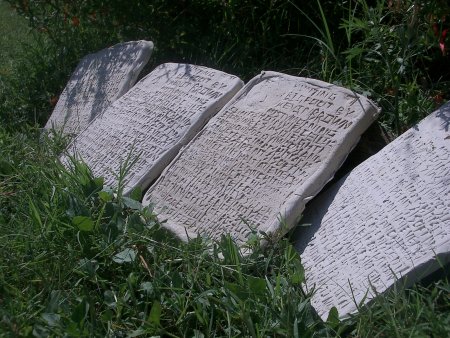For Public Release: 8/25/10
Contact: Matthew Bey, Publisher and Communications Director, Space Squid
email: squishy-at-spacesquid-dot-com
Literary Magazine to Print on Dead Media — Clay Tablets
As digital media threatens traditional print periodicals with economic and cultural obsolescence, some magazines are returning to their ancient roots. Austin-based science fiction and humor magazine Space Squid will print its ninth issue on clay tablets.
“Print is dead,” says Space Squid design editor Steve Wilson. “So there’s no reason not to print on the deadest media available. There isn’t much difference between dead media and really, really dead media.”

Faced with steep printing costs and the bulk of their readership downloading the online PDF of the magazine, the editors of Space Squid made the decision to return to clay tablets. Space Squid communications editor Matthew Bey says, “Given the choice between printing 2000 paper copies that won’t last ten years, or thirty copies that can last six thousand years, it’s an easy choice to make.”
“Sometimes archaic media just works better,” says Space Squid art editor David Chang. “In some respects, clay is a superior recording medium. It has more warmth and depth of tone than paper.”
The clay tablets are unfired as was common practice in Sumeria. Like their historical antecedents they are dried in the sun, giving them a startling durability. “Practically speaking, these tablets could last until the end of the world itself,” says Chang. “Unless someone drops them.”
The Space Squid clay tablet is the first major cultural application of clay tablets since the collapse of Egyptian colonialism in the first century A.D. The tablets are printed using a unique technology that allows multiple impressions of the same text, despite recording on a medium that pre-dates Gutenberg by thousands of years.
Says Bey, “If the Sumerians had been as clever as Space Squid and developed a similar clay-printing technology, they would have sparked the enlightenment era a thousand years before the birth of Christ.”

The clay tablet issue contains most of the content familiar to readers of the paper version of Space Squid. Side one has a seal-imprint with the image of a squid and the name “Space Squid” in phonetic cuneiform. The rest of the front-face features a short story by Kevin Brown titled “Hunting Bigfoot,” hand-lettered in the English alphabet using a wedged stylus in the same manner as the Sumerian scribes. The back side contains an off-color joke and advertisements for the Drabblecast podcast, the movie Bikini Bloodbath, illustrator David Johnston, Krakatoa Shirts, and a live performance of the graphic novel Intergalactic Nemesis.
Space Squid will print less than 15 clay tablets. Only five tablets will go up for auction at the Armadillocon art show, open to members of the Armadillocon science fiction convention. One tablet will go up for sale on eBay. The remaining tablets are reserved for private collections.
Space Squid, which is known for printing edgy and often humorous fiction, has a history of pushing boundaries. In 2009 Space Squid staff experimented with zombie-killing techniques, using actual weapons and actual heads, posting their scientific results on Youtube.
A digital PDF of Space Squid issue 9, with far more content, will be available at spacesquid.com.
For more information:
Space Squid:
http://www.spacesquid.com/
Video of clay tablet printing:
http://www.youtube.com/watch?v=0gg6oNMB6Fg
Photos of clay tablet printing:
http://www.revolutionsf.com/bb/weblog_entry.php?e=2539
Armadillocon:
http://www.armadillocon.org/
Zombie head bashing experiment:
http://www.youtube.com/watch?v=CSd7SbO9I8U